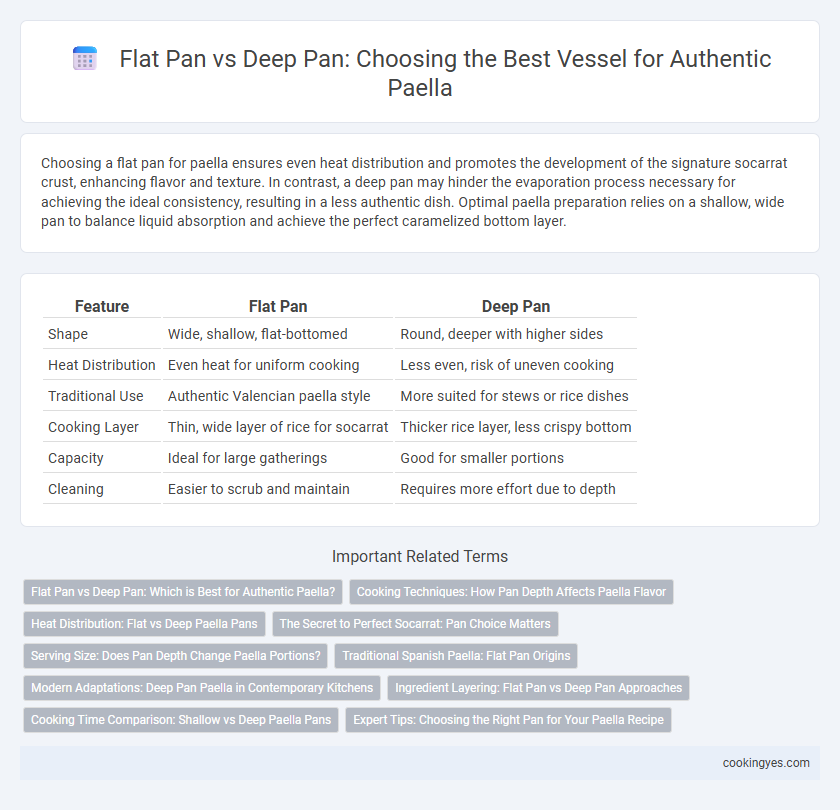Choosing a flat pan for paella ensures even heat distribution and promotes the development of the signature socarrat crust, enhancing flavor and texture. In contrast, a deep pan may hinder the evaporation process necessary for achieving the ideal consistency, resulting in a less authentic dish. Optimal paella preparation relies on a shallow, wide pan to balance liquid absorption and achieve the perfect caramelized bottom layer.
Table of Comparison
| Feature | Flat Pan | Deep Pan |
|---|---|---|
| Shape | Wide, shallow, flat-bottomed | Round, deeper with higher sides |
| Heat Distribution | Even heat for uniform cooking | Less even, risk of uneven cooking |
| Traditional Use | Authentic Valencian paella style | More suited for stews or rice dishes |
| Cooking Layer | Thin, wide layer of rice for socarrat | Thicker rice layer, less crispy bottom |
| Capacity | Ideal for large gatherings | Good for smaller portions |
| Cleaning | Easier to scrub and maintain | Requires more effort due to depth |
Flat Pan vs Deep Pan: Which is Best for Authentic Paella?
A flat pan, known as a paellera, is ideal for authentic paella as it ensures even heat distribution and allows the rice to cook uniformly, creating the signature socarrat crust at the bottom. Deep pans tend to trap steam, resulting in a softer texture that deviates from traditional paella's slightly toasted and dry finish. Choosing a flat paella pan enhances the cooking process by mimicking the original Valencian method, balancing heat exposure and moisture for perfect rice and flavor development.
Cooking Techniques: How Pan Depth Affects Paella Flavor
A flat paella pan ensures even heat distribution and faster evaporation, creating the desired socarrat crust critical for authentic Valencian paella flavor. In contrast, a deep pan retains more moisture, resulting in a softer texture and less caramelized rice, which alters the traditional flavor profile. Optimal paella cooking leverages the shallow pan's ability to balance moisture and heat, enhancing the dish's complex, toasted notes.
Heat Distribution: Flat vs Deep Paella Pans
Flat paella pans offer superior heat distribution due to their wide, shallow design that allows for even cooking and the characteristic socarrat crust formation. Deep paella pans tend to concentrate heat unevenly, often resulting in inconsistent cooking and longer cooking times. Optimal heat exposure in flat pans ensures the ideal texture and flavor balance essential for traditional paella.
The Secret to Perfect Socarrat: Pan Choice Matters
Achieving the perfect socarrat in paella hinges on pan selection, where a flat pan evenly distributes heat to create the prized golden crust without burning. Deep pans trap moisture, hindering the formation of the socarrat and resulting in a less crispy texture. Choosing a wide, shallow paella pan ensures optimal heat exposure, essential for developing the signature caramelized bottom layer.
Serving Size: Does Pan Depth Change Paella Portions?
Paella pan depth influences serving size by affecting the rice and ingredient volume it can hold, with flat pans typically allowing for more even cooking and consistent portions per serving. Deep pans accommodate larger quantities but may result in uneven heat distribution, potentially altering texture and flavor balance in each portion. Choosing between flat and deep pans depends on desired batch size and presentation, as a flat pan yields traditional, thinner layers ideal for shared paella meals.
Traditional Spanish Paella: Flat Pan Origins
Traditional Spanish paella originates from the use of a flat, wide pan called a "paellera," which allows even cooking and the formation of the prized socarrat crust. The shallow design promotes quick evaporation of liquid, essential for achieving the dish's authentic texture and concentrated flavors. Deep pans alter the cooking dynamics, often resulting in uneven heat distribution and a departure from the classic paella experience.
Modern Adaptations: Deep Pan Paella in Contemporary Kitchens
Modern adaptations of paella often favor deep pans for their versatility in contemporary kitchens, allowing for easier stirring and layering of ingredients. Deep pans retain heat efficiently, supporting the slow cooking process essential for developing rich, complex flavors in paella. This shift from traditional flat pans accommodates diverse recipes while maintaining the dish's authentic texture and taste.
Ingredient Layering: Flat Pan vs Deep Pan Approaches
Flat pans enable even heat distribution, allowing ingredients like rice, seafood, and vegetables to cook simultaneously in a uniform layer, which is essential for developing the traditional socarrat crust. Deep pans require careful layering and staggered cooking times to ensure thorough cooking of denser ingredients without overcooking delicate components on top. Ingredient layering in flat pans emphasizes a wide, shallow spread promoting consistent flavor absorption, while deep pans necessitate strategic placement to balance moisture and texture across varying depths.
Cooking Time Comparison: Shallow vs Deep Paella Pans
Shallow paella pans enable faster cooking times due to their wide surface area that promotes even heat distribution and quick evaporation of liquid, essential for achieving the traditional socarrat crust. Deep paella pans retain more liquid and heat, resulting in longer cooking times and a softer rice texture, which differs from the classic paella consistency. Chefs seeking authentic texture and flavor prefer shallow pans for their ability to cook rice uniformly and develop the prized caramelized bottom layer.
Expert Tips: Choosing the Right Pan for Your Paella Recipe
Experts recommend a wide, flat pan for traditional paella to ensure even heat distribution and maximize the surface area, promoting the signature socarrat crust. A deep pan can retain more liquid but may result in uneven cooking and a less authentic texture. Selecting a carbon steel flat pan with angled sides enhances heat conduction and ease of stirring, essential for perfect paella preparation.
Flat Pan vs Deep Pan for Paella vessel Infographic

 cookingyes.com
cookingyes.com